Fulfilling the need for speed: Drill bit designs drilling further, faster
Manufacturers continue to adapt cutter shapes, improve fluid circulation characteristics and alter depth-of-cut elements to achieve higher ROPs and less bit wear, particularly in hard and interbedded formations
By Alex Endress, Editorial Coordinator
- Ridged shaped cutting elements are helping bits to build sharper curves in horizontal wellbores.
- Rolling depth-of-cut elements roll against the formation, reducing friction and wear.
- Curved nozzle design redirects fluid flow to move bottomhole impact point toward shoulder of bit in softer formations.
- Larger roller cone cutting structure allows for more tungsten carbide inserts to increase durability in hard formations.
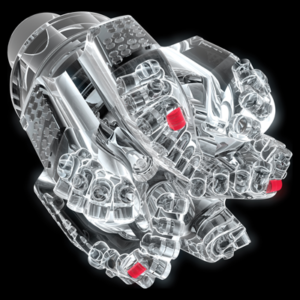
Modern drill bits have improved exponentially over the past several years, but operators continue to raise the bar in terms of expectations for more efficiency and durability. From horizontal wells in North American shales to Middle Eastern wells with 3,000- to 6,500-ft sections and even some deepwater wells using rotary steerable systems, operators now oftentimes expect to drill entire hole sections without tripping out for a new bit. “More than 60% of the sections drilled around the world today are already done with one bit, which means that the primary way to reduce customers’ drilling costs in those sections is to significantly increase ROP,” said Allen White, Product Champion at Smith Bits, a Schlumberger company.
In many cases, enhanced cutting structures are being used to increase the effective engagement of the formation, enabling higher ROP. National Oilwell Varco (NOV), for example, has designed shaped cutters to increase formation fracture propagation to concentrate more force onto a defined point, increasing drilling efficiency in tough and hard formations.
Bit manufacturers are also adjusting the fluid circulation characteristics of bits. This can help to prevent cuttings buildup, which can severely reduce ROP. “We’ve found that the root cause of a dull condition isn’t always due to impact or pure abrasion,” said Matthew Schnuriger, Regional Field Engineer at Varel International. “It can also be the result of poor fluid dynamics that are unable to efficiently evacuate cuttings and cool the cutting structure under high energy loads.”
In this article, DC speaks with Baker Hughes, Halliburton, NOV, Schlumberger, Ulterra Drilling Technologies and Varel for perspectives on state-of-the-art drill bit technologies.
In harsh drilling environments with hard and interbedded rock formations, bits often face high compressive strength rock and/or cuttings buildup, both of which induce dull cutting structures and overall damage to the bit. To address these challenges, NOV launched the Tektonic fixed-cutter bit platform last year. These bits feature the new Reflektor 3D polished PDC cutters, which increase the effectiveness of rock failure by using point loading. This makes them highly effective in clastic rock compared with conventional cylindrical-shaped cutters.
Watch the video above with NOV’s Alexis Garcia, Product Line Director, Performance Series Drill Bits, about the Tektonic fixed-cutter bit platform.
“The use of Reflektor 3D cutters dramatically increases drilling effectiveness, resulting in ROP gains of up to 20% on average and without significant impact in dull condition,” said Alexis Garcia, NOV Product Line Director, Performance Series Drill Bits. “With conventional cylindrical cutters, the rock tends to fracture on the front of the cutter, staying below the formation surface. The shape of the new cutter promotes cracks to propagate toward the formation surface, enabling cutters to remove that portion of rock more easily.”

Further, the highly polished cutter face reduces friction between the rock and cutters, minimizing heat generation. Standard unpolished cutters can be rougher and cause increased friction between the drill bit and the formation, Mr Garcia said.
As part of the Tektonic platform, NOV also introduced a hydraulic package. HydroShear nozzles and a cuttings evacuation grooves reduce heat accumulation, extending cutter life. The nozzles increase hydraulic shear on the bit shoulder cutters, which tend to experience the highest thermal degradation. This reduces heat accumulation and aids in cutting evacuation by reducing chip size. The evacuation grooves allow the secondary cutting row to effectively remove cuttings directly up the wellbore.
“Normally, PDC bits are designed in such a way that the tool’s cutting structures are very close together,” Mr Garcia said. “Because of that proximity, the cuttings tend to pack in between the primary and secondary cutting structures of the bit. That’s when you begin to lose ROP. These features allow us to drill more efficiently by mitigating high temperatures and cuttings buildup.”
Dynamic rotation modeling software from NOV arranges bit components to best suit the formation by orienting cutters for optimized placement based on downhole loading and eccentricity. “The software helps us design the bit for the specific application the operator has in mind,” Mr Garcia said.
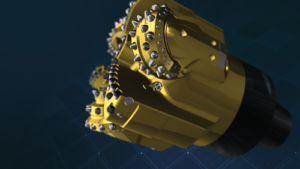
In August 2016, the new PDC bit was deployed for a well in Oman. The operator sought to increase ROP in the limestone formation, which was interbedded with sandstone, dolomite and shale. The bit drilled a total of 4,669 ft (1,423 m), from 3,228 ft to 7,897 ft, and was pulled from the well with a dull grade of 1-1-BT-A-X-I-NO-PR.
The ROP in the 12 ¼-in. section averaged 98 ft/hr, with no bit balling experienced. All four offset PDC bit applications in similar 12 ¼-in. vertical sections experienced bit balling and achieved an average ROP of only 62.6 ft/hr. Besides the Middle East, Tektonic bits with similar characteristics have been deployed in other onshore and offshore wells in the US, Europe, Canada, Latin America, West Africa, Australia and Southeast Asia.
Denser cutting structure for durability
Baker Hughes launched the third iteration of its Kymera PDC roller cone hybrid drill bit in September 2016. The Kymera XTreme hybrid bit has been given a sharper and more dense cutting structure to boost ROP and durability in hard carbonates and interbedded rock. The roller cones cutting structure is now larger to make room for 50% more tungsten carbide inserts than its predecessor, the Kymera FSR hybrid bit. That iteration had been designed to improve speed and control in softer directional applications, but it was less durable when drilling in harder formations. This new technology release of Kymera XTreme is faster and more durable and aims to improve performance in more challenging carbonates and interbedded formations in the US, Canada, United Kingdom, Africa, Australia and Middle East.
“Carbonate formations have always been a challenge with prior hybrid drill bit technologies, and traditional bits performed the job with low efficiency and low rate of penetration,” said Franklin Guillermo Valbuena Ramirez, Drilling Optimization Engineer at Baker Hughes. “This created the need to increase the durability and efficiency of previous designs and offer a replacement for traditional bits while drilling long interbedded carbonate formations.”
Watch the video above with Baker Hughes’ Shelly Cory, Global Product Line Manager, Kymera Drill Bits, on the new iteration of the Kymera PDC roller cone hybrid drill bit.
The Kymera XTreme bit builds on lessons learned from roller cone bits in carbonate formations, as well as from PDC bits in interbedded formations. “The bit was engineered to optimize the combination of crushing action of the cones and the shearing action of the PDC cutters,” Mr Valbuena Ramirez said.
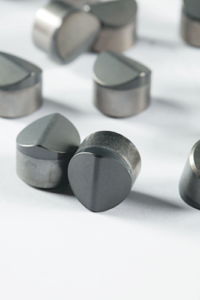
Since the bit’s commercial launch, it has completed approximately 80 runs in Canada and 20 runs in the Middle East, including Oman, Kuwait and Saudi Arabia. In November 2016, the bit completed a 16-in. 3,000-ft hard and interbedded vertical rock section for an onshore well in Saudi Arabia. “The lithology was mainly carbonate, but in the middle of the section were interbedded sandstones and pyrite nodules,” Mr Valbuena Ramirez said. “It is difficult to drill this type of formation with roller cones that can dull fairly quickly in the sandstones before reaching the other parts of the formation.”
The carbonate section ran from approximately 3,000-ft deep to 6,000 ft, with interspersed sandstone and pyrite beginning at about 4,500 ft. The total depth of the well was 6,000 ft. Before drilling, it was estimated the section would require two bits to drill, but the operator was able to finish it using only one Kymera XTreme drill bit. Out of six offset wells, three of them required two tricone bits to complete similar 3,000-ft well sections. Average ROP for the six offset wells was 30 ft/hr, versus 80 ft/hr with Kymera XTreme.
Ridged shaped Cutting element improves penetration, steerability
In March 2016, Smith Bits launched the AxeBlade Ridged Diamond Element Bit, which features ridge-shaped cutting elements across the blades and combines shearing and crushing actions to increase ROP and reduce torque. Traditional flat cylindrical PDC cutters can limit depth of cut and create substantial friction with the formation while drilling, which increases torque and reduces ROP.
The more-aggressive ridged shape of the Axe elements are able to help focus the force more efficiently on the formation ahead. “With the ridge shape, the new cutting elements actually cut about 22-25% deeper into the formation, which translates to a step-change improvement in ROP,” Mr White said.
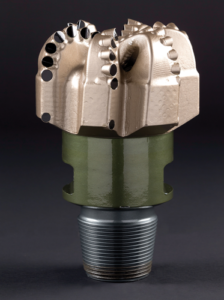
In addition to improving ROP, the ridge shape also cuts with approximately 20% less torque than traditional PDC cutters. By reducing torque, the PDC bit is able to build a sharper curve in horizontal wellbores to give the lateral as much exposure to the producing formation as possible. As well as increasing steerability, the reduction in torque has created other benefits to customers such as increasing downhole tool life and reducing torsional vibrations.
Since its launch a year ago, the bit has been used in more than 600 runs, primarily in the US and Canada, although the technology has also been deployed in Latin America, Europe, the Middle East, Russia and Asia.
In October 2016, the bit was used to drill a 12 ¼-in. vertical section in Oman’s challenging Natih deep gas field. “The operator was having a difficult time drilling these types of sections with one bit at an optimal ROP,” Mr White said. The 8,200-ft section was interbedded with softer Natih Limestone and the hard and abrasive Al Khalata Sandstone.
By running the new AxeBlade bit, the operator was able to drill the section in a single bit run with an average ROP of 90 ft/hr. The run was 18% faster than the field-best 12 ¼-in. section, whose normalized ROP averaged 76 ft/hr and 42% faster than the field normalized average ROP for similar 12 ¼-in. sections, which was 63 ft/hr.
To date, the AxeBlade bit has been used to drill nine runs on this field. “After the 12 ¼-in. applications, the operator approached us about developing an AxeBlade design for their 8 ¾-in. lateral section. That design has been completed, and we should be drilling those sections in Oman by early 2017,” Mr White said.
Curved nozzles help avoid bit balling
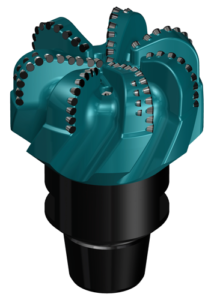
In formations with high clay content, such as those often found in the Permian Basin, bit balling has become an increasingly common challenge as drilling speeds increase. In the presence of clay content, cuttings can stick together, ball up and block the drilling fluid nozzles on drill bits. “A lot of operators are going to larger and more aggressive bits to drill deeper wells as fast as they can with as few bits as possible,” Varel’s Mr Matthew Schnuriger said. “We’ve reached the ROP limit at which the bit can clean itself effectively with standard nozzles.”
In response, in January 2016 Varel released a curved nozzle design for steel body PDC drill bits drilling in softer formations, such as shale in West Texas. “By redirecting the fluid flow with the curved nozzles, we can move the bottom-hole impact point farther out toward the shoulder of the bit. This better utilizes the fluid energy by focusing it across the blade toward the area where the most cuttings are generated,” Mr Schnuriger said.
In September 2016, the curved nozzles were used on a steel body PDC bit along with a mud motor to finish the last 2,000 ft of a 6-in. 9,000-ft lateral section in the Delaware Basin. Five other PDC bits with standard nozzles had failed to complete the section and to reach the well’s measured depth of 21,000 ft. “In a lot of shales, such as the Wolfcamp, you’ll see a high percentage of clay mixed in that causes them to be more sticky, plastic and malleable, which can cause bit balling,” Mr Schnuriger said. “On top of that, operators often use higher mud weights in these applications for well stability. This can negatively affect the cleaning efficiency of the fluid as it reduces fluid velocity across the bit.” In the September 2016 run, the operator was using a 14 lb/gal oil-based mud for the 6-in. interval.
The interval began at 11,000 ft, and the first five PDC bits were pulled out at depths of 12,000 ft, 14,000 ft, 16,000 ft, 17,000 ft and 19,000 ft. One bit was pulled for severely worn cutters, and another was pulled due to BHA tool failure. The other three were pulled due to bit balling in the center nozzles. “At higher mud weights, the energy available in the fluid at the bit is limited, which inhibits efficient cleaning when generating large cuttings. Instead of evacuating the large cuttings, some can pack off in the center of the bit,” Mr Schnuriger said.

After a new PDC bit incorporating the curved nozzles was sent downhole, it finished drilling the interval while avoiding bit balling. The bit was then deployed in a separate well to drill 7,000 ft of a 9,000-ft lateral section. The operator pulled the bit in order to deploy a rotary steerable system for the section’s final 2,000 ft. ROP on the sections using curved nozzles averaged 68.78 ft/hr, versus 49.61 ft/hr for footage drilled with standard-nozzle bits, according to Varel.
Rolling elements reduce friction
Standard static depth-of-cut elements on PDC bits wear as footage is drilled, which can lead to torque fluctuations, cutter over-engagement and difficulty controlling tool face. “As you turn the drill bit, that creates friction. If you are using standard static depth-of-cut elements, they will drag across the formation, creating torque fluctuations, which can make toolface control difficult to maintain,” said KC Deagman, Halliburton Senior Application Evaluation Specialist. “It can also wear the elements down and cause them to lose the benefits associated with depth-of-cut control.”
To reduce friction on PDC depth-of-cut elements, Halliburton launched the Cruzer Depth-of-Cut Rolling Element for PDC bits in fall 2016. Instead of remaining static and dragging across the formation, these PDC elements roll against the formation as the bit is turned. “It’s similar to holding a rubber ball and dragging it across a table – that creates some friction. If you put the ball on the table and roll it, that reduces the friction,” Mr Deagman explained. “If you can reduce that friction downhole, it will increase ROP and keep the primary cutting structure sharper for longer to avoid reduction of ROP during drilling.” Reducing friction while sliding also allows the operator to hold toolface more easily and, thus, steer the drill bit along the desired wellbore path.
During the nine months the cutting elements were under development, they were tested on curve applications in places as varied as the Eagle Ford, Oklahoma’s Mississippi Lime, Saudi Arabia and the Williston Basin. “Anytime there is a directional need, the depth-of-cut control is a very useful feature for the directional driller to have while steering the bit,” Mr Deagman said. “The rolling element just takes depth-of-cut one step further to reduce drag while steering the bit.”
In November 2016, an operator used a Halliburton 8 ¾-in. MegaForce PDC bit to drill the Williston Basin’s hard limestone with a goal of increasing ROP. The bit drilled the 830-ft section, from 10,680-ft MD to 11,510-ft MD, with an average ROP of 59.3 ft/hr. The 10 other wells on this 11-well pad had all been drilled using PDC bits with standard cutting elements, and their ROPs averaged 46.5 ft/hr.
The rolling depth-of-cut elements are currently available only on Halliburton’s PDC bits and steel body bits. The company says it is evaluating the potential for rolling out the technology as a complete replacement for its static depth-of-cut element.
Drilling in deepwater
Ulterra Drilling Technologies initially launched its CounterForce PDC bit in 2013 for rotary steerable applications in North American shales. Since then, the company has been moving the technology into the deepwater arena. “We realized the deepwater market was perfectly set up for the bit because RSS is used almost exclusively in this market,” said Matt Case, Ulterra Regional Engineering Manager, Eastern US.
Designed with alternating side rakes, the bit counteracts lateral forces caused by vibrations that are a common limitation in directional wells. Intense vibrations can dull the bit, as well as break down sensitive electronics in the rotary steerable system.
In developing the CounterForce bit, Ulterra had looked to the machining and automotive industries and adapted their stagger tooth mill and chevron tire pattern, respectively. Both design techniques reduce lateral forces in their respective industries. When incorporated into a drill bit, “it creates a pushback when there’s a lateral force on the bit or the drillstring,” Mr Case said. “The lateral force is being accounted for by the cutters and side rakes that are angled at different degrees. Therefore, the bit drills more stably because the cutters have a way to reduce the impact of vibrations on the bit.”
By designing the bit with alternating side rakes instead of parallel side rakes, which are common on standard PDC bits, the CounterForce gains better traction against the formation. “It’s going to act as a dampening effect to whirl or stick-slip, so the magnitude of the vibration forces aren’t so high,” Mr Case said.
In 2014, Ulterra began deploying the technology in the deepwater Gulf of Mexico, targeting RSS applications in long and abrasive rock intervals where durability and stability are needed the most.
In one particular deepwater GOM application in Q1 2016, the operator was experiencing problems with vibrations and premature bit wear while drilling an abrasive subsalt Miocene formation. “Once the bit transitioned into the Miocene, the stick-slip would get very high and became the limiting factor for ROP,” Mr Case said. The bit was deployed to drill the 10 5/8-in. 7,905-ft section that began at a well depth of 24,000 ft, an anticipated two-bit interval. However, the new PDC bit with CounterForce technology was able to drill the entire section in one run with 106 drilling hrs – 10 days ahead of schedule.
There were three nearby offset 10 5/8-in. sections that had been drilled in 2015. The first measured 5,718-ft long and was drilled in 125 drilling hours using one bit; the second was 8,906-ft long and was drilled in 244 drilling hours using two bits; and the third section, 5,981-ft long, was drilled using three bits with just over 200 drilling hours.
Since October 2014, the CounterForce bits have been deployed in 13 deepwater intervals on seven wells with six sizes in the southeastern GOM and is expected to drill its 14th and 15th intervals in early 2017. DC
Tektonic, Reflektor and HydroShear are trademarks of National Oilwell Varco. Kymera is a registered trademark of Baker Hughes.




